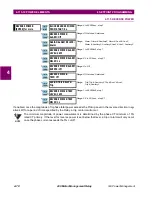
GE Power Management
469 Motor Management Relay
4-55
4 SETPOINT PROGRAMMING
4.8 S7 MOTOR STARTING
4
4.8.3 JOGGING BLOCK
a) FUNCTION
The Jogging Block feature may be used to prevent operators from jogging the motor (multiple starts and stops
performed in rapid succession). It consists of two distinct elements: Starts/Hour and Time Between Starts.
The Starts/Hour feature does not guarantee that a certain number of starts or start attempts will be allowed
within an hour; rather, it ensures that a certain number of start attempts will not be exceeded within an hour.
Similarly, the Time Between Starts feature does not guarantee another start will be permitted if the
TIME
BETWEEN STARTS PERMISSIBLE
elapses after the most recent start. Rather, it ensures a minimum time between
starts. If however, the first start attempt from cold is unsuccessful due to a jam or it takes long because the pro-
cess is overloaded, the Thermal Model might reduce the number of starts that can be attempted within an hour.
It may also cause a lockout time that exceeds a Time Between Starts lockout that may have been active. Such
a thermal lockout will remain until the motor has cooled to an acceptable temperature for a start.
b) STARTS / HOUR
A motor start is assumed to be occurring when the 469 measures the transition of no motor current to some
value of motor current. At this point, one of the Starts/Hour timers is loaded with 60 minutes. Even unsuccess-
ful start attempts will be logged as starts for this feature. Once the motor is stopped, the number of starts within
the past hour is compared to the number of starts allowable. If the two numbers are the same, a block will
occur. If a block occurs, the lockout time will be equal to the longest time elapsed since a start within the past
hour, subtracted from one hour.
For example, if
MAX. STARTS/HOUR PERMISSIBLE
is programmed at
"2"
,
•
one start occurs at T = 0 minutes,
•
a second start occurs at T = 17 minutes,
•
the motor is stopped at T = 33 minutes,
•
a block occurs,
•
the lockout time would be 1 hour – 33 minutes = 27 minutes.
c) TIME BETWEEN STARTS
A motor start is assumed to be occurring when the 469 measures the transition of no motor current to some
value of motor current. At this point, the Time Between Starts timer is loaded with the entered time. Even
unsuccessful start attempts will be logged as starts for this feature. Once the motor is stopped, if the time
elapsed since the most recent start is less than the
TIME BETWEEN STARTS PERMISSIBLE
setpoint, a block will
occur. If a block occurs, the lockout time will be equal to the time elapsed since the most recent start sub-
tracted from the
TIME BETWEEN STARTS PERMISSIBLE
. A value of
"0"
effectively disables this element.
For example, if
TIME BETWEEN STARTS PERMISSIBLE
is programmed = 25 min.
•
a start occurs at T = 0 minutes,
•
the motor is stopped at T = 12 minutes,
•
a block occurs,
•
the lockout time would be 25 minutes – 12 minutes = 13 minutes
y
JOGGING BLOCK
y
[ENTER] for more
JOGGING BLOCK:
Off
Range: On, Off
MAX. STARTS/HOUR
PERMISSIBLE: 3
Range: 1 to 5, step 1
TIME BETWEEN STARTS
PERMISSIBLE: 10 min.
Range: 0 to 500 min., step 1
ENTER
ESCAPE
ð
ð
MESSAGE
ESCAPE
MESSAGE
ESCAPE
















































